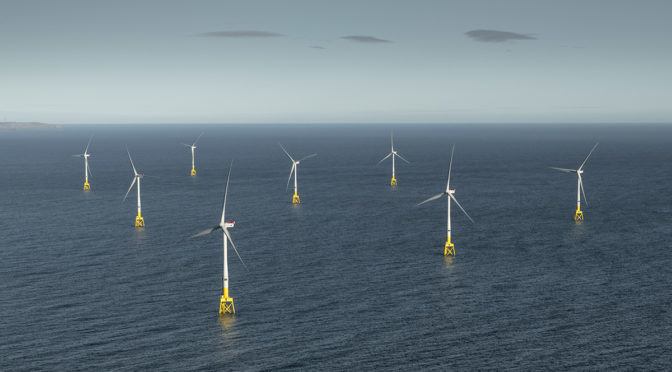Japan’s offshore wind farm market is set to gain momentum, with legal safeguards and subsidies helping to draw domestic and international participants amid a shift away from fossil fuels.
Japanese leasing company Orix and Tokyo Electric Power Co. Holdings, as well as E.ON — Germany’s largest power provider — are among those planning to establish wind farms offshore.
Solar power has driven Japan’s renewable energy push, but investment in the weather-dependent sector has slowed as subsidies decrease. Meanwhile, onshore wind farms face noise pollution concerns, making offshore sites attractive for the government to promote over the longer term and for the private sector looking to develop new earnings streams.
A bill passed last November allows wind farms to operate in Japan’s territorial waters for up to 30 years.
Orix will spend 100 billion yen ($903 million) to build a wind farm off the coast of Chiba Prefecture. The farm will consist of about 20 large turbines able to provide 200 megawatts of electricity, or enough to power 170,000 households. Orix started surveying the ocean bottom at the end of January, with plans to launch operations in fiscal 2025 upon government approval.
Tepco will enter the domestic offshore wind power market as well through a partnership with Denmark’s Orsted, the world’s largest operator in the field.
E.ON will establish a Japanese arm as early as this summer. The company, which has developed 1.8 gigawatts’ worth of offshore wind projects across Europe, will partner with Japanese power providers to build both onshore and offshore wind farms.
Japanese trading company Marubeni has started feasibility testing at home with the aim of using the know-how to build and operate offshore wind farms. The company gained institutional knowledge in 2012 after purchasing British wind farm installer Seajacks International.
Mitsubishi Heavy Industries is developing a 10-MW wind turbine, the largest of its kind, through a joint venture with Denmark’s Vestas Wind Systems. The wind turbine will eventually be sold in Japan.
Europe is home to over 4,000 wind turbines spread across 11 countries, thanks to timely rule setting and continual development. Meanwhile, offshore wind farms are extremely scarce in Japan, even though the country is the world’s fourth-largest energy consumer. The lack of clear regulations governing the sector had been a barrier. Wind power accounts for over 10% of total electricity generated in the U.K. and Germany, yet the comparable figure in Japan is below 1%.
Following the Fukushima nuclear disaster, no new reactors are expected to be built in Japan in the foreseeable future. Coal makes up about a third of Japan’s energy mix, but the rise of sustainable investing is forcing a transition to alternative sources of energy. The government’s latest energy plan calls for developing renewables into a central part of the mix.
About 80% of renewable energy investment in Japan has gone to solar power, although funding in that sector has slowed dramatically. Growth is inhibited by a shortage of locations that can accommodate megasolar plants. The government is also reducing fixed prices for solar projects in the feed-in-tariff system, a move that undercuts profitability. Around 1.7 trillion yen was invested in solar power last year in Japan, data from Bloomberg NEF shows, or about half the peak level.
Onshore wind farms face resistance because of noise pollution concerns. Yet large offshore wind farms can be built since they are often located far from residential areas. In addition, offshore farms benefit from a feed-in-tariff price of 36 yen per kilowatt-hour, which is double the price for solar energy, and more than the 20 yen fetched by onshore wind generators. “You can make sufficient profit,” said an industry insider.
Offshore wind power has taken off in Europe because of an abundance of suitable coastal areas. In some parts of Europe, wind energy generation costs have dropped to the same level as coal-fired power. Japan, however, is mostly surrounded by precipitously deep seabeds. Only a few prefectures are near shallow water that can support wind turbines attached to the ocean floor.
Floating wind turbines present one workaround. Development is ongoing, but the costs are still relatively high. With onshore wind farms included, running a wind energy business in Japan is about 60% more expensive than the global average.


